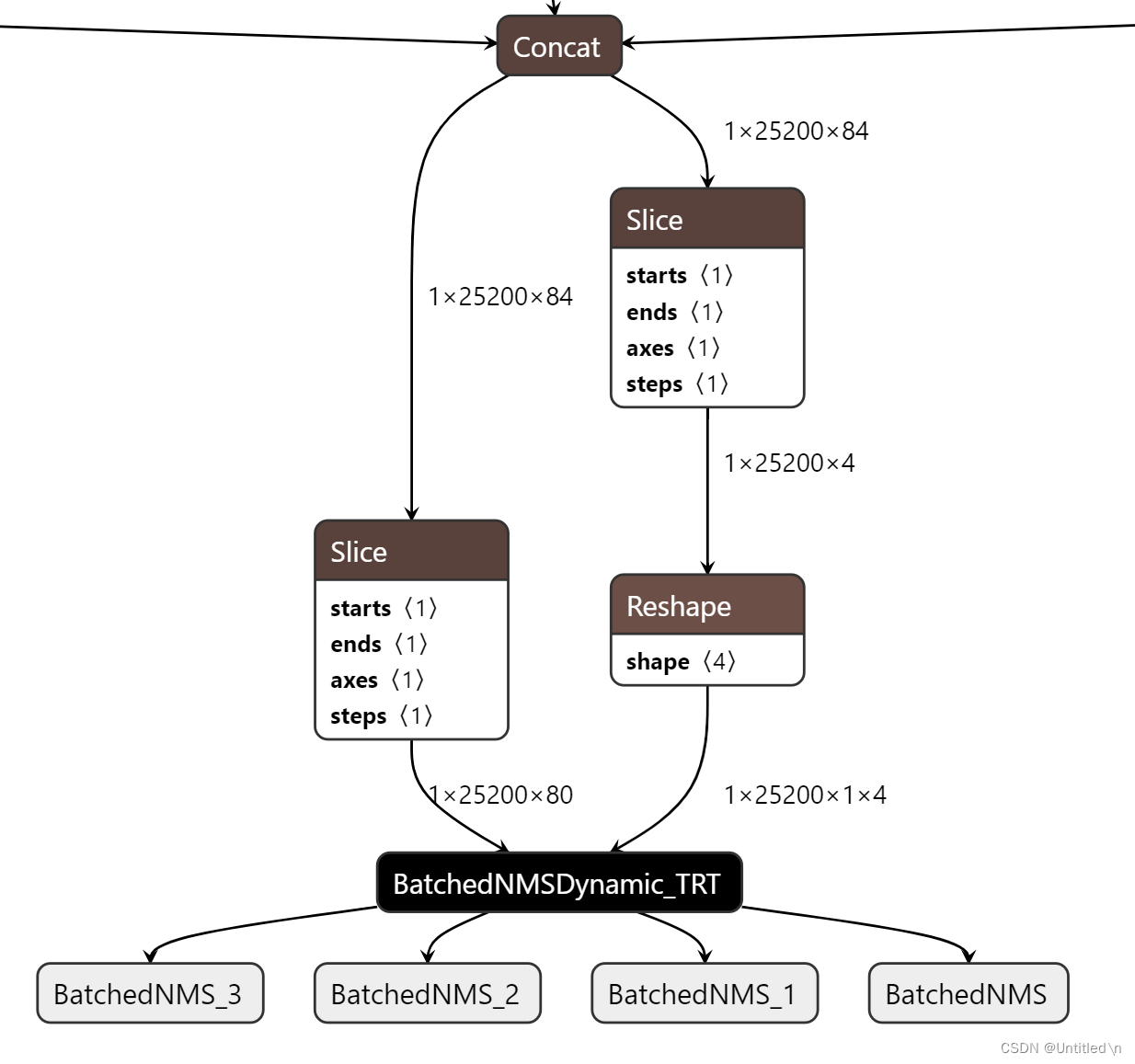YOLOV5 TensorRT BatchedNMS
在修改yolov5的detect层一文中,介绍了对detect层的轻量化改造,以提高模型服务的效率。在Triton Pipelines部署yolov5 service一文中利用改造的模型文件分别通过BLS和Ensemble两种方式部署了Triton Pipelines。但是Pipelines中的infer engine和nms始终是两个相对独立的step,由于nms是通过python backend来完成的,无论是BLS还是Ensemble都在数据传输方面存在一些限制。
本文利用onnx_graphsurgeon改造原生detect层的输出张量,对接通过cuda实现的TensorRT batchedNMSPlugin,将yolov5的nms集成到tensorrt engine中,避免部分场景下device to host的数据拷贝,提高整体计算性能。
0. 前置条件
# clone ultralytics repo
git clone -b v6.1 https://github.com/ultralytics/yolov5.git
# clone this repo
git clone <this repo>
cp -r <this repo>/* yolov5/
1. 具体步骤
同修改yolov5的detect层#3-具体步骤大致类似,都是遵循:
- 修改detect层的forward函数
- 导出.onnx文件
- 转换为trt engine
的步骤。只不过这里需要对导出onnx文件的函数进行一些修改,新增一个BatchedNMSDynamic_TRT node并追加到原始graph的末尾, 并按照TensorRT batchedNMSPlugin的输入格式调整node的属性
1.1 修改前后
-
infer模式下forward函数原始输出格式
-
squeezed boxes and classes:
[batch_size, number_boxes, box_xywh + c + number_classes] = [batch_size, 25200, 85]
-
-
修改后的输出格式
-
boxes
[batch_size, number_boxes, 1, x1y1x2y2] -
cls_conf
[batch_size, number_boxes, number_classes]
根据batchedNMSPlugin.cpp源码中的注释,boxes的输入形状为
[batch_size, num_boxes, num_classes, 4] or [batch_size, num_boxes, 1, 4],但batchedNMSPlugin的文档没有详细说明这二者的差别,在
efficientNMSPlugin的文档里可以找到相关的解释:The boxes input can have 3 dimensions in case a single box prediction is produced for all classes (such as in EfficientDet or SSD), or 4 dimensions when separate box predictions are generated for each class (such as in FasterRCNN), in which case number_classes >= 1 and must match the number of classes in the scores input. The final dimension represents the four coordinates that define the bounding box prediction.
由于使用的是yolov5, 所以不会对每个类别去生成bouding box, 所以boxes的输入形状应该为
[batch_size, num_boxes, 1, 4]
-
1.2 改造detect层
yolov5 Detect层forward函数的输出改成TensorRT batchedNMSPlugin的输入格式
def forward(self, x):
z = [] # inference output
for i in range(self.nl):
x[i] = self.m[i](x[i]) # conv
bs, _, ny, nx = x[i].shape # x(bs,255,20,20) to x(bs,3,20,20,85)
x[i] = x[i].view(bs, self.na, self.no, ny, nx).permute(0, 1, 3, 4, 2).contiguous()
if not self.training: # inference
if self.onnx_dynamic or self.grid[i].shape[2:4] != x[i].shape[2:4]:
self.grid[i], self.anchor_grid[i] = self._make_grid(nx, ny, i)
y = x[i].sigmoid()
if self.inplace:
y[..., 0:2] = (y[..., 0:2] * 2 - 0.5 + self.grid[i]) * self.stride[i] # xy
y[..., 2:4] = (y[..., 2:4] * 2) ** 2 * self.anchor_grid[i] # wh
else: # for YOLOv5 on AWS Inferentia https://github.com/ultralytics/yolov5/pull/2953
xy = (y[..., 0:2] * 2 - 0.5 + self.grid[i]) * self.stride[i] # xy
wh = (y[..., 2:4] * 2) ** 2 * self.anchor_grid[i] # wh
# custom output >>>>>>>>>>>>>>>>>>>>>>>>>>>>>>>>>>>>>>>>>>>>>>>>>>>>>>>>
conf = y[..., 4:]
xmin = xy[..., 0:1] - wh[..., 0:1] / 2
ymin = xy[..., 1:2] - wh[..., 1:2] / 2
xmax = xy[..., 0:1] + wh[..., 0:1] / 2
ymax = xy[..., 1:2] + wh[..., 1:2] / 2
obj_conf = conf[..., 0:1]
cls_conf = conf[..., 1:]
cls_conf *= obj_conf
# y = torch.cat((xy, wh, y[..., 4:]), -1)
y = torch.cat((xmin, ymin, xmax, ymax, cls_conf), 4)
# z.append(y.view(bs, -1, self.no))
z.append(y.view(bs, -1, self.no - 1))
z = torch.cat(z, 1)
bbox = z[..., 0:4].view(bs, -1, 1, 4)
cls_conf = z[..., 4:]
return bbox, cls_conf
# return x if self.training else (torch.cat(z, 1), x)
# custom output >>>>>>>>>>>>>>>>>>>>>>>>>>>>>>>>>>>>>>>>>>>>>>>>>>>>>>>>
1.3 修改export_onnx
export onnx时,修改output,满足TensorRT batchedNMSPlugin的输入格式
这里介绍一下关键点,详细代码见export.py中的export_onnx函数
-
onnx simplify的时候避免导出成static shape
model_onnx, check = onnxsim.simplify( model_onnx, dynamic_input_shape=dynamic # 必须注释 #input_shapes={'images': list(im.shape)} if dynamic else None ) -
利用onnx-graphsurgeon创建一个
BatchedNMSDynamic_TRTnode,并添加到原有计算图的末尾# add batch NMS: yolo_graph = onnx_gs.import_onnx(model_onnx) box_data = yolo_graph.outputs[0] cls_data = yolo_graph.outputs[1] nms_out_0 = onnx_gs.Variable( "BatchedNMS", dtype=np.int32 ) nms_out_1 = onnx_gs.Variable( "BatchedNMS_1", dtype=np.float32 ) nms_out_2 = onnx_gs.Variable( "BatchedNMS_2", dtype=np.float32 ) nms_out_3 = onnx_gs.Variable( "BatchedNMS_3", dtype=np.float32 ) nms_attrs = dict() # ........ nms_plugin = onnx_gs.Node( op="BatchedNMSDynamic_TRT", name="BatchedNMS_N", inputs=[box_data, cls_data], outputs=[nms_out_0, nms_out_1, nms_out_2, nms_out_3], attrs=nms_attrs ) yolo_graph.nodes.append(nms_plugin) yolo_graph.outputs = nms_plugin.outputs yolo_graph.cleanup().toposort() model_onnx = onnx_gs.export_onnx(yolo_graph) -
依次导出onnx和tensorrt engine
# export onxx python export.py --weights yolov5s.pt --include onnx --simplify --dynamic # export trt engine /usr/src/tensorrt/bin/trtexec \ --onnx=yolov5s.onnx \ --minShapes=images:1x3x640x640 \ --optShapes=images:1x3x640x640 \ --maxShapes=images:1x3x640x640 \ --workspace=4096 \ --saveEngine= yolov5s_opt1_max1_fp16.engine \ --shapes=images:1x3x640x640 \ --verbose \ --fp16 \ > result-FP16-BatchedNMS.txt
2. 性能测试
2.1 COCO17 validation数据集测试
对比测试infer + nms的耗时
-
original yolo
python detect.py --weight original-yolov5s-fp16.engine --half --img 640 --source </path/to/coco/images/val2017/> --device 0Speed: 0.8ms pre-process, 4.4ms inference, 2.2ms NMS per image at shape (1, 3, 640, 640)
-
batchedNMSPlugin
python trt_infer.py --model yolov5s_opt1_max1_fp16.engine --input_images_folder </path/to/coco/images/val2017/> --output_images_folder <output_tempfolder> --input_size 640infer + nms:
Inference: 5.4 ms per image at shape (1, 3, 640, 640)
2.2 trtexec 测试
trtexec是本地测试结果,batch为1的情况下,整体差别不太大,将nms集成到trt engine后,Output的张量变小了很多,可以降低Device to Host的数据传输时间,代价是GPU Compute的时间增加
| metrics | BatchedNMSDynamic_TRT egine infer+nms |
ultralytics engine only infer |
|---|---|---|
| Latency | 3.97021 ms | 4.08145 ms |
| End-to-End Host Latency | 6.70715 ms | 4.73285 ms |
| Enqueue Time | 1.27597 ms | 0.95929 ms |
| H2D Latency | 0.563791 ms | 0.316406 ms |
| GPU Compute Time | 3.45068 ms | 2.41992 ms |
| D2H Latency | 0.0100889 ms | 1.34198 ms |